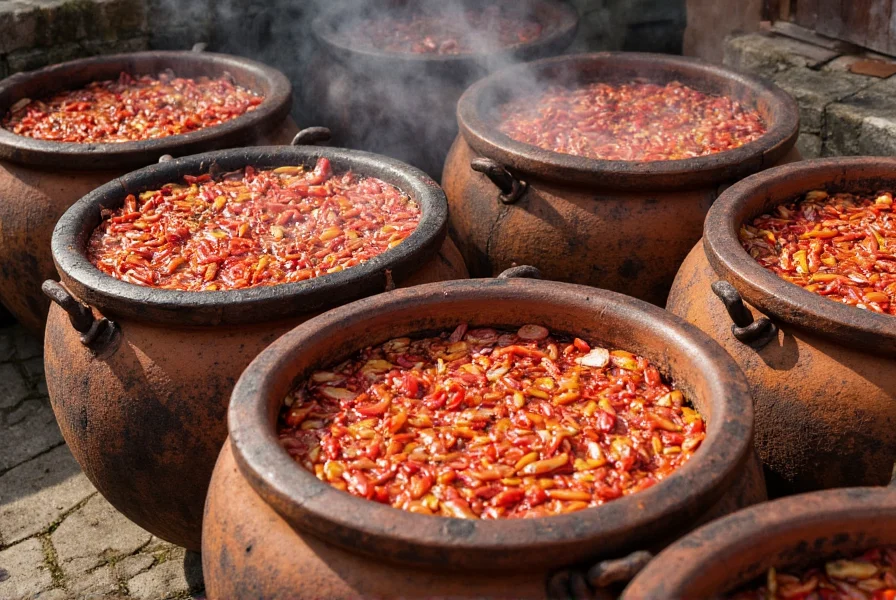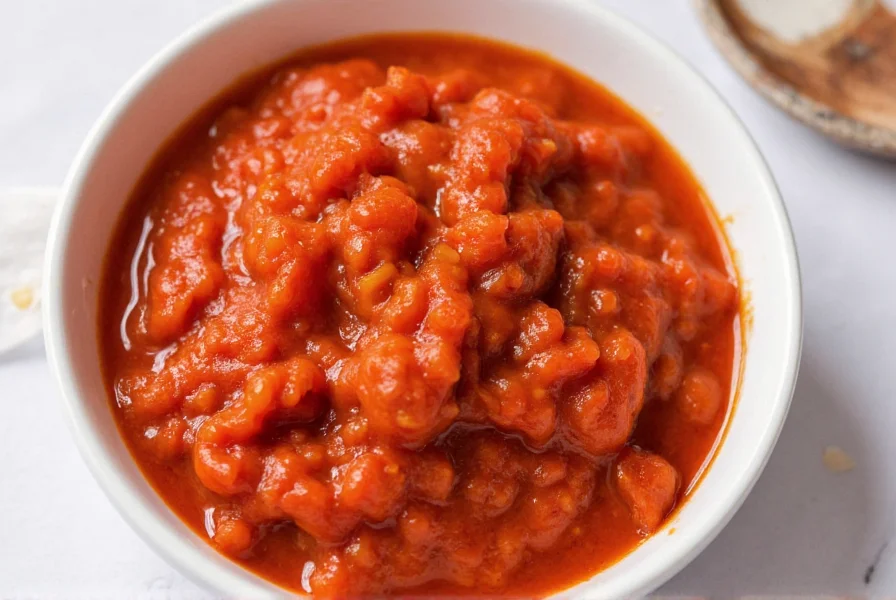Understanding this essential Korean ingredient opens doors to authentic cooking experiences. Gochujang's distinctive taste comes from its fermentation process, which develops layers of flavor you won't find in ordinary hot sauces. Unlike Western chili pastes, gochujang balances heat with sweetness and savory depth, making it incredibly versatile in the kitchen.
The Historical Roots of Gochujang
Originating during Korea's Three Kingdoms period (57 BCE–668 CE), gochujang evolved after chili peppers arrived via trade routes in the 16th century. Traditional Korean households still prepare this fermented chili paste using time-honored methods passed down through generations. The fermentation process, typically lasting 6-12 months, transforms simple ingredients into a complex culinary staple.
Authentic Gochujang Ingredients and Production
True Korean gochujang contains just four essential components:
| Ingredient | Role in Gochujang | Traditional Source |
|---|---|---|
| Red chili powder (gochugaru) | Provides heat and color | Sun-dried Korean chili peppers |
| Glutinous rice (chapssal) | Creates sweetness through fermentation | Steamed and powdered |
| Meju powder (fermented soybeans) | Contributes umami and depth | Traditional Korean soybean fermentation |
| Brine salt solution | Preserves and enhances fermentation | Sea salt dissolved in water |
Commercial varieties sometimes add sweeteners like sugar or corn syrup, but authentic homemade gochujang relies solely on natural fermentation for its characteristic sweetness. The traditional production involves mixing ingredients, forming into blocks called tteok, and aging in onggi (Korean earthenware pots) under controlled conditions.

Flavor Profile and Characteristics
Gochujang's magic lies in its balanced complexity. Unlike gochugaru (Korean chili powder), which provides pure heat, gochujang offers:
- Spicy heat (moderate to high, depending on brand)
- Sweetness from naturally fermented rice
- Umami depth from fermented soybeans
- Savory richness developed during aging
- Subtle tanginess from the fermentation process
The paste typically has a thick, spreadable consistency similar to tomato paste, with a deep red color ranging from bright crimson to dark brick red depending on age and ingredients. When evaluating gochujang vs sriracha differences, remember that sriracha delivers straightforward heat with vinegar tang, while gochujang provides multidimensional flavor.
Culinary Applications of Gochujang
This versatile Korean chili paste enhances countless dishes beyond traditional Korean recipes. Professional chefs and home cooks use gochujang for:
Marinades and Glazes
Combine gochujang with garlic, sesame oil, and honey for exceptional meat marinades. The natural sugars caramelize beautifully when grilled or roasted. Try this gochujang marinade recipe for bulgogi or chicken:
- 3 tablespoons gochujang
- 2 tablespoons soy sauce
- 1 tablespoon rice vinegar
- 1 tablespoon honey or sugar
- 2 cloves garlic, minced
- 1 teaspoon sesame oil
- 1 teaspoon grated ginger
Sauces and Dressings
Whisk gochujang with vinegar, oil, and sweeteners to create complex dipping sauces or salad dressings. Many restaurants use gochujang as the base for modern fusion sauces that pair well with everything from roasted vegetables to seafood.
Stir-fries and Braises
Add 1-2 tablespoons to stir-fries during the final minutes of cooking. The paste dissolves into the sauce, adding depth without overwhelming heat. For authentic Korean stews like soondubu jjigae (soft tofu stew), gochujang forms the flavor foundation.
Modern Fusion Applications
Chefs increasingly incorporate gochujang into unexpected dishes:
- Spicy mayo replacements for sandwiches and burgers
- Flavor boost in tomato-based pasta sauces
- Unique pizza sauce alternative
- Enhancement for roasted vegetable glazes
- Base for creative cocktail mixers

Storage and Shelf Life
Proper storage maintains gochujang's quality and extends its shelf life. Follow these gochujang storage tips:
- Store unopened containers in a cool, dark pantry for up to 1 year
- Refrigerate after opening to preserve flavor (essential for homemade varieties)
- Always use clean, dry utensils to prevent contamination
- Press plastic wrap directly onto the surface before closing to minimize oxidation
- Check for mold or off odors before use (properly stored gochujang rarely spoils)
Commercial gochujang typically remains safe for 6-12 months refrigerated after opening, while homemade versions may last 3-6 months. The flavor often improves with short-term aging in the refrigerator.
Substitutes and Alternatives
When you need gochujang substitute options, consider these alternatives based on your recipe's requirements:
| Substitute | Best For | Ratio | Limitations |
|---|---|---|---|
| Doubanjiang + sweetener | Stews and braises | 1:1 with 1 tsp sugar | Lacks sweetness, different bean base |
| Sriracha + miso + honey | Marinades and sauces | 1 tbsp sriracha + 1 tsp miso + 1 tsp honey | Thinner consistency, less complex |
| Chili garlic paste + tomato paste | Stir-fries | 1:1 ratio | Missing umami depth |
| Gochugaru + fermented elements | Authentic Korean dishes | 1 tbsp gochugaru + 1 tsp soybean paste + 1 tsp sugar | Requires additional ingredients |
No substitute perfectly replicates authentic Korean gochujang ingredients and fermentation process, but these combinations work in emergencies. For best results, seek authentic Korean brands like Chung Jung One or Sempio when possible.
Common Misconceptions About Gochujang
Several myths persist about this Korean staple:
- "Gochujang is extremely spicy" - Most commercial varieties offer moderate heat, milder than many think. The sweetness balances the spice.
- "It's just like sriracha" - Gochujang vs sriracha differences are significant: gochujang has fermented complexity while sriracha delivers straightforward heat.
- "All gochujang tastes the same" - Regional variations and production methods create distinct flavor profiles between brands.
- "It contains artificial additives" - Traditional recipes use only natural ingredients, though some commercial versions add sweeteners.
Where to Find Quality Gochujang
Locating authentic Korean gochujang requires knowing where to look. Major supermarkets often carry popular brands in the international aisle, but for the best selection:
- Korean or Asian grocery stores (best selection and price)
- Online specialty food retailers
- Gourmet food stores with international sections
- Some farmers' markets with international vendors
When searching for where to buy gochujang near me, check the ingredient list for minimal additives. The best products list only chili powder, glutinous rice, fermented soybeans, and salt. Avoid versions with corn syrup or artificial preservatives for authentic flavor.
Nutritional Profile and Health Considerations
Gochujang offers more than just flavor. Traditional fermentation provides potential health benefits:
- Naturally contains probiotics from the fermentation process
- Provides capsaicin, which may support metabolism
- Contains antioxidants from chili peppers
- Glutinous rice contributes complex carbohydrates
While gochujang nutritional benefits exist, consume in moderation as part of a balanced diet. A typical serving (1 tablespoon) contains approximately 20-30 calories, 4-5g carbohydrates, and minimal fat. Those monitoring sodium intake should note that gochujang contains salt as a preservative and flavor enhancer.
Exploring Gochujang in Your Kitchen
Start incorporating this versatile Korean chili paste with these simple approaches:
- Stir a teaspoon into mayonnaise for sandwich spreads
- Add to salad dressings for depth of flavor
- Whisk with honey and soy sauce for meat glazes
- Mix with tomato paste for pizza sauce alternatives
- Stir into soups and stews during the last 10 minutes of cooking
Remember that gochujang's flavor develops when heated, so add it early enough in cooking to allow flavors to meld, but not so early that the delicate fermented notes burn off. The paste dissolves completely when properly incorporated into liquids.
Frequently Asked Questions
What's the difference between gochujang and gochugaru?
Gochugaru is Korean red chili powder, while gochujang is a fermented chili paste. Gochugaru provides pure heat and color, similar to paprika, whereas gochujang combines chili powder with fermented soybeans and glutinous rice to create a complex paste with spicy, sweet, and umami flavors. You can think of gochugaru as an ingredient in gochujang.
Is gochujang gluten-free?
Traditional gochujang made with glutinous rice (which is gluten-free despite the name) is naturally gluten-free. However, some commercial brands may use wheat-based ingredients or process in facilities with gluten. Always check labels if you have gluten sensitivity, and look for products specifically labeled gluten-free when necessary.
How spicy is gochujang compared to other hot sauces?
Gochujang typically ranges from 1,500 to 10,000 Scoville units, making it milder than many Western hot sauces. Most commercial varieties offer moderate heat balanced by sweetness. For reference, it's generally less spicy than sriracha (2,200-5,000 Scoville) but provides more complex flavor. The heat level varies by brand and specific recipe.
Can I make gochujang at home?
Yes, you can make homemade gochujang, though the traditional process requires fermentation time. Authentic Korean gochujang recipe methods involve mixing gochugaru, meju powder (fermented soybean powder), glutinous rice powder, and salt with brine, then aging for 6-12 months. Simplified home versions use miso paste as a fermentation shortcut but won't replicate the authentic depth of traditionally aged gochujang.
Does gochujang need refrigeration after opening?
Yes, refrigeration after opening significantly extends gochujang's shelf life and preserves flavor quality. While the high salt content provides some preservation, refrigeration prevents mold growth and maintains the complex flavor profile. Properly stored in the refrigerator with clean utensils, opened gochujang remains safe for 6-12 months. Always check for off odors or visible mold before use.











 浙公网安备
33010002000092号
浙公网安备
33010002000092号 浙B2-20120091-4
浙B2-20120091-4